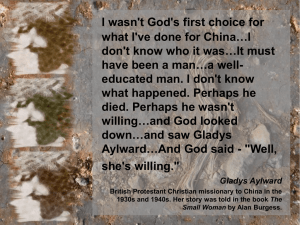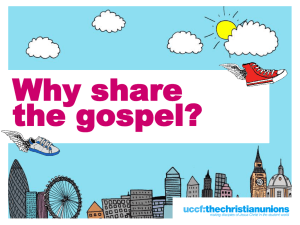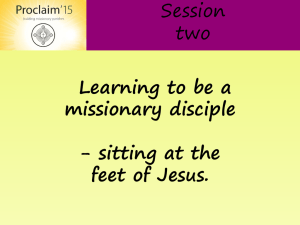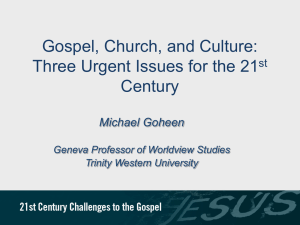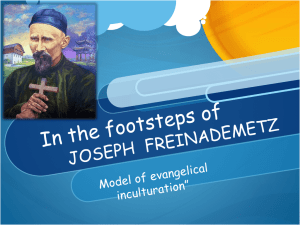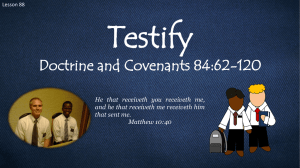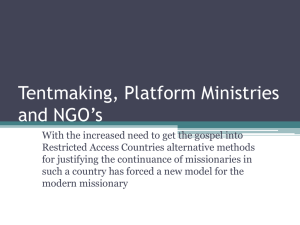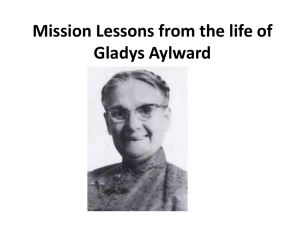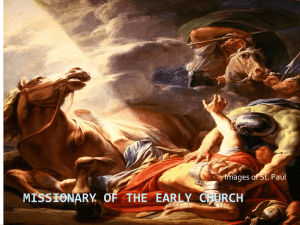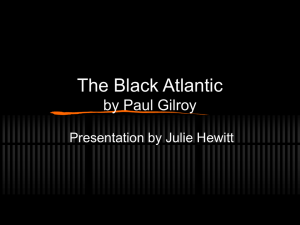2. Missionary Apostolate (pp. 556–564)
advertisement
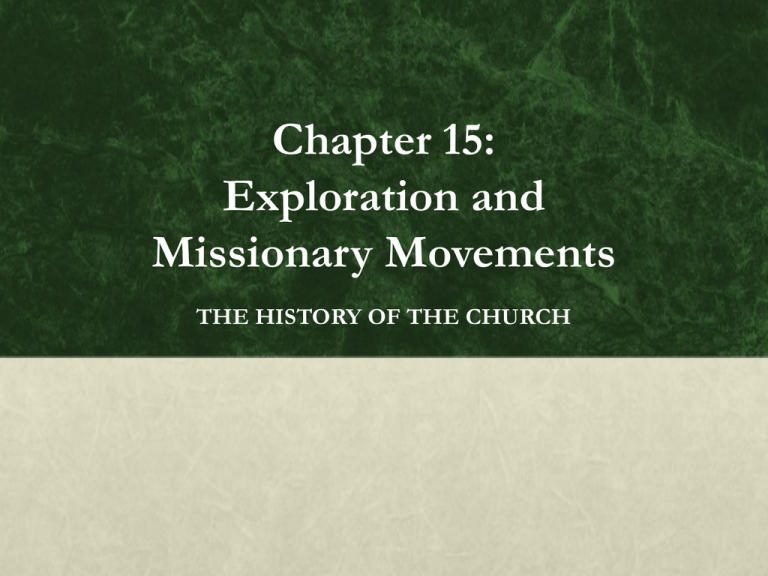
Chapter 15: Exploration and Missionary Movements THE HISTORY OF THE CHURCH 1. Opening the Atlantic (pp. 544–555) ANTICIPATORY SET Analyze the illustration of the New World (“Novus Orbis,” p. 545). Identify features of the map and explain why they are so distorted compared to modern maps. 1. Opening the Atlantic (pp. 544–555) BASIC QUESTIONS What factors made the Age of Exploration possible? What were the positive and negative effects of the Age of Exploration? KEY IDEAS Technical innovations in the maritime arts and a desire to bypass the trade monopoly of the Ottoman Empire and Italian merchants launched the Age of Exploration. The Portuguese searched for and found an eastern route to markets in the Far East. The Spanish sponsored Columbus, who set out to find a direct western route to China and India. His discovery of the West Indies set off a frenzy of exploration, including the first circumnavigation of the globe by Magellan. Mercantilism and the Columbian Exchange had profound effects on the world, both positive—developing the economies and increasing the food supply of Europe—and negative—slavery, serfdom, massive epidemics, and the destruction of native cultures. 1. Opening the Atlantic (pp. 544–555) FOCUS QUESTION How did the European economy motivate people during the Age of Exploration? After the fall of Constantinople, it became increasingly difficult and costly to receive goods from the East through the Ottoman Turks, and the farther west one lived, the more expensive were those imported goods. Spanish and Portuguese interests wanted to find a way to bypass Turkish and Italian middlemen. 1. Opening the Atlantic (pp. 544–555) FOCUS QUESTIONS How did government exploration and merchant trade beget one another? Government-sponsored explorations opened up new trading opportunities, which increased tax revenues, funded further exploration, and opened up further merchant trading. What technological innovations aided the Age of Exploration? Prince Henry the Navigator’s school employed cosmographers and mathematicians to improve the quality of maps, charts, and navigational techniques. The compass and astrolabe were important new navigational instruments. The new caravel could sail against the wind, through high 1. Opening the Atlantic (pp. 544–555) GRAPHIC ORGANIZER Complete the following table about the causes of exploration. 1. Opening the Atlantic (pp. 544–555) 1. Opening the Atlantic (pp. 544–555) GUIDED EXERCISE Work with a partner to list the features that made the caravel the best ship of its time. 1. Opening the Atlantic (pp. 544–555) FOCUS QUESTIONS What was important about the voyage of Bartholomew Diaz? He sailed down the west coast of Africa and around the Cape of Good Hope, proving it was possible to bypass the Ottoman-controlled land route to the East. What was the importance of Vasco da Gama’s voyage? He sailed all the way to India, almost discovering Brazil in the process. What did the Portuguese establish? They established the first worldwide trading empire. 1. Opening the Atlantic (pp. 544–555) GRAPHIC ORGANIZER Work with a partner to complete the following table according to the map “Voyages of Discovery” (pp. 548–549). 1. Opening the Atlantic (pp. 544–555) 1. Opening the Atlantic (pp. 544–555) FOCUS QUESTION Why was Columbus rejected by Portugal and sponsored by Spain? Columbus wanted to reach India by sailing westward. The Portuguese were committed to opening an eastern route to India around Africa, so they were not interested. The Spanish, wanting to compete against Portugal, were open to alternate routes. 1. Opening the Atlantic (pp. 544–555) FOCUS QUESTIONS Why did Columbus think he could reach China by sailing westward? The second-century geographer Ptolemy wrote that the Eurasian land mass stretched halfway around the northern hemisphere. Columbus reasoned he could reach the easternmost part of China by sailing westward that distance. How far from Europe did Columbus estimate China to be? He calculated 2400 miles, which is a little less than the distance to the New World. 1. Opening the Atlantic (pp. 544–555) FOCUS QUESTIONS What did Magellan accomplish? His crew circumnavigated the globe. For the first time, people had an accurate idea of the breadth of the earth. Who were conquistadors? They were Spanish soldiers of fortune who conquered the Aztec, Inca, and other peoples in Central and South America. 1. Opening the Atlantic (pp. 544–555) FOCUS QUESTIONS What other European nations joined the Age of Exploration? France, the Netherlands, and England also explored the New World. What did Columbus think he had found, and what had he found? He thought he had reached the archipelagos, which holds the great island cities of China, but he actually found the Bahamas. 1. Opening the Atlantic (pp. 544–555) FOCUS QUESTIONS What was the effect of Columbus’s success? It set off a frenzy of exploration to the New World, pitting Spain and Portugal in competition for colonial territory. What was the “Line of Demarcation” (Tordesillas Line)? Drawn by Pope Alexander VI, it ceded land east of it to Portugal and west to Spain. Extension: Since no one knew how much land was to the west, Spain was granted unwittingly much more land: almost the whole of the Americas. 1. Opening the Atlantic (pp. 544–555) FOCUS QUESTION What were some negative effects of the Age of Exploration? The gold and silver mined in the New World and imported to Europe inflated the money supply. England resorted to piracy to steal gold before it could reach Spain. Serfdom, which bound peasants to the land, was introduced in Germany and Austria and other Eastern European areas that could not compete with colonial agriculture in the New World. Mercantilism became dependent on slave labor. Disease brought by Spanish conquistadors killed thousands of native people, and colonizers disrupted and sometimes destroyed the indigenous peoples’ ways of life. 1. Opening the Atlantic (pp. 544–555) FOCUS QUESTIONS What effect did the discovery of the New World have on the common laborer in Europe? New foods such as squash, potatoes, and beans were introduced to Europe, increasing the food supply. What is mercantilism? This economic theory holds that nations should import raw materials and export finished goods, thus creating a surplus of capital for investment. What was the Columbian Exchange? It was the widespread exchange of agricultural goods, animals, plants, diseases, and ideas between the eastern and western hemispheres, which began after 1492. 1. Opening the Atlantic (pp. 544–555) FOCUS QUESTIONS What were some effects of the Columbian Exchange? It brought the potato from South America to Ireland and coffee from the Near East to the Andes. Horses and cattle were brought to the Americas, oranges to Florida, and bananas to Ecuador. Tomatoes, paprika, tobacco, peanuts, and cocoa were brought to Europe. What effect did the Columbian Exchange have on the Plains Indians? They captured and learned to ride horses that had escaped from the Spanish, becoming nomadic, horseback bison hunters. 1. Opening the Atlantic (pp. 544–555) GRAPHIC ORGANIZER Work with a partner to complete the following table according to the map “Missionary Voyages” (p. 554). 1. Opening the Atlantic (pp. 544–555) 1. Opening the Atlantic (pp. 544–555) HOMEWORK ASSIGNMENT Study Questions 1–14 (pp. 576–577) Practical Exercise 1 (p. 577) Workbook Questions 1–21 Read “Missionary Apostolate” through “The Philippines and Africa” (pp. 556–564) 1. Opening the Atlantic (pp. 544–555) CLOSURE Write a paragraph explaining the factors that contributed to the Age of Exploration. 1. Opening the Atlantic (pp. 544–555) ALTERNATIVE ASSESSMENT Work with a partner to discuss how the Age of Exploration reveals both the greatness of man and the reality of Original Sin. 2. Missionary Apostolate (pp. 556–564) ANTICIPATORY SET Search the Internet for and view a map drawn by Matteo Ricci about 1620. 2. Missionary Apostolate (pp. 556–564) BASIC QUESTIONS How did missionaries overcome formidable obstacles to evangelize the people of the Far East? What were some accomplishments of St. Francis Xavier and Matteo Ricci? What is inculturation, and why is it effective? KEY IDEAS Despite many obstacles to missionary activity, the discovery of new lands and the reforms of the Ecumenical Council of Trent resulted in an outpouring of evangelical spirit. St. Francis Xavier was perhaps the most successful missionary since St. Paul, winning large numbers of converts in India and Japan and leaving behind a strong administrative system and well-trained successors. In China Matteo Ricci provided a textbook example of how to evangelize a culture that was both hostile to Christianity and considered itself superior to it. Inculturation—learning the language and customs of the people being evangelized and adapting the expression of the Faith to that culture—was effective in India, China, Japan, and the Philippines. 2. Missionary Apostolate (pp. 556–564) FOCUS QUESTIONS What effect did the Catholic Reformation have on evangelization? The Catholic Reformation encouraged dedicated missionaries to spread the Gospel to newly encountered people. What is De Propaganda Fide? This congregation was founded by the Pope in 1622 to promote and establish apostolic missions. 2. Missionary Apostolate (pp. 556–564) FOCUS QUESTIONS What was the basic difference between how the Catholic and Protestant settlers saw the native peoples? In North America the Spanish and French Catholic settlers saw the native people as human beings who should be protected, who could learn Spanish or French culture, and who could be converted and intermarry with Europeans. The English and Dutch Protestant settlers tended to see the natives as reprobates who may be killed and their lands seized. What was the importance of Fr. Bartolome de las Casas? He was the first priest in the New World. He renounced his encomienda and fought to eradicate Indian and African slavery. 2. Missionary Apostolate (pp. 556–564) GUIDED EXERCISE Read silently the selection from “History of the Indians” (p. 575), and then discuss the following questions: According to Fr. Bartolome de las Casas, what basic method should a missionary employ in a pagan land? Do you agree with him? 2. Missionary Apostolate (pp. 556–564) FOCUS QUESTIONS What big obstacles did the missionaries face? Vast distances to travel, extreme climates, differences in language, hostile natives, and the poor examples of many European settlers were obstacles to the work of missionaries. What bad examples did many early European settlers set in missionary territories? Many early settlers were opportunistic adventurers—who were prone to mistreating and enslaving local peoples—or government officials who violated the native peoples’ human rights. 2. Missionary Apostolate (pp. 556–564) FOCUS QUESTIONS According to tradition, who brought Christianity to India? St. Thomas the Apostle brought Christianity to India. Is this tradition true? The scholarly consensus is that this tradition seems to be true. 2. Missionary Apostolate (pp. 556–564) FOCUS QUESTION What is known about St. Thomas Christians? Though they left no written records, they were influenced by heretical Nestorians, which had proliferated in Mesopotamia; enjoyed a high status in Indian society; and had an archdeacon in charge; parish councils; a liturgy that included days of fasting and abstinence; and churches similar in style to Hindu temples and Jewish synagogues. 2. Missionary Apostolate (pp. 556–564) FOCUS QUESTIONS When St. Francis Xavier arrived in India, how did he counter the scandalous activities of the European settlers there? He worked for five months to reform their immoral behaviors. What made St. Francis Xavier so successful? Besides his tireless activity, he learned the languages of the peoples he evangelized and displayed a simple charity toward all. 2. Missionary Apostolate (pp. 556–564) FOCUS QUESTIONS What was St. Francis Xavier’s legacy? He converted tens of thousands of Indians. St. Francis Xavier always left behind well trained successors and a strong administrative structure to continue to serve the newly evangelized peoples. What did missionary success in Japan entail? While the Japanese were open to conversion, evangelization required the permission of the Shogun, the strongest tribal warlord. St. Francis baptized some 2000 Japanese. 2. Missionary Apostolate (pp. 556–564) FOCUS QUESTIONS Why did St. Francis Xavier seek entry to China, even though, if caught, he could be executed? He heard about the magnificent culture of the Celestial Empire and wanted to bring the Faith to it. How did St. Francis’s life end? He died before he could reach the mainland of China. Extension: St. Francis Xavier is credited with having converted more people than anyone since St. Paul. 2. Missionary Apostolate (pp. 556–564) FOCUS QUESTIONS Who first evangelized China? Matteo Ricci evangelized China. Why was China uniquely difficult to evangelize? The Chinese were satisfied with the excellence of their traditions, which included ancestor worship and philosophy based on truth and justice. They had no inclination to embrace a new civilization or religion from the West. 2. Missionary Apostolate (pp. 556–564) FOCUS QUESTIONS How did Ricci evangelize the Chinese? Ricci appreciated and valued the culture that he had entered. He blended the eastern and western worlds in an attractive and compatible way— dressing as a Mandarin scholar—yet filled his residence with Western works of art and scientific instruments. Through his exemplary virtues and tantalizing glimpses into Western civilization, Ricci earned respect and attracted the attention of the emperor, whom he befriended. How did the missionaries in India practice inculturation? They assimilated local customs, learned various dialects, and integrated themselves into the communities. 2. Missionary Apostolate (pp. 556–564) FOCUS QUESTIONS How did Robert de Nobili apply inculturation to the high caste of Brahmins? He mastered Hindi and Sanskrit, studied the Brahmins, and learned what they held sacred and worthy of reverence. He fasted and abstained from foods that they considered unclean. With the permission of his bishop, he presented himself as a Christian Brahmin holy man to show Christian virtues in a way that the Brahmins could recognize. What was the result of De Nobili’s respect for the Brahmin caste? He converted some 150,000 souls. 2. Missionary Apostolate (pp. 556–564) FOCUS QUESTIONS How did Matteo Ricci make Christianity attractive to the Chinese people? Besides his friendship with the emperor, Ricci gave lectures on science and astronomy, translated Christian principles into Chinese, and composed a liturgical rite in the vernacular. How did Chinese Catholicism appear at its apex? Ricci converted some 2000 Chinese. Under his successor, the number grew to 237,000. In 1692 the emperor granted complete toleration to the Church, and by 1724 the number of Chinese Catholics rose to 800,000. 2. Missionary Apostolate (pp. 556–564) FOCUS QUESTIONS What caused a decline in Chinese Christianity? The Chinese became wary of Western domination and began persecutions in 1724, which impacted missionary activity. The suppression of the Jesuit order in 1773 also diminished the number of available priests. By the end of the century, the number of Chinese Catholics was only about 300,000. In Japan, how did the Shogun view the Faith? At the time of St Francis Xavier, the Shogun permitted missionary activity, which resulted in some 200,000 fervent converts. A later Shogun prohibited Christianity. 2. Missionary Apostolate (pp. 556–564) FOCUS QUESTIONS Why were there so many Japanese Christians martyred? The Shogun was afraid of invasion and the destruction of Japanese civilization. Many Japanese Catholics were tortured and crucified as Christianity was suppressed. When Japan reopened herself, what did French missionaries discover? They found some 50,000 secret Japanese Christians, who had retained the Faith for almost 300 years. Remarkably, they still pledged obedience to the Pope, venerated the Blessed Virgin Mary, and practiced clerical celibacy. 2. Missionary Apostolate (pp. 556–564) GUIDED EXERCISE Work with a partner to contrast the different experiences of the Church in the Philippines and on the continent of Africa. 2. Missionary Apostolate (pp. 556–564) HOMEWORK ASSIGNMENT Study Questions 15–21 (p. 577) Practical Exercise 2 (p. 577) Workbook Questions 22–44 Read “The New World” through “Conclusion” (pp. 564–574) 2. Missionary Apostolate (pp. 556–564) CLOSURE Write a one-paragraph essay in which you define inculturation and show how Robert de Nobili exemplified this among the Brahmins of India. 2. Missionary Apostolate (pp. 556–564) ALTERNATIVE ASSESSMENT Work with a partner to make a graph charting the growth and decline of Catholicism in China from the late sixteenth until the end of the eighteenth century. 3. The New World (pp. 564–574) ANTICIPATORY SET Discuss the following question: Based on last night’s reading, what did the Church do to promote the rights of native peoples in the Americas? 3. The New World (pp. 564–574) BASIC QUESTIONS What did the conquistadors Cortez and Pizarro accomplish? How did the conversion of Mexico occur? How did the evangelization of North America begin? KEY IDEAS Cortez and Pizarro, audacious and brutal adventurers, conquered the Aztec and Inca Empires, respectively. The conversion of Mexico was effected miraculously by the Blessed Virgin Mary (Our Lady of Guadalupe). Heroic missionaries and Popes tried to protect the native peoples and African slaves from European settlers’ greed and inhumanity. In North America French priests were the first martyrs, and English Catholics established the Colony of Maryland. 3. The New World (pp. 564–574) FOCUS QUESTIONS How did Spain show that it was serious about the propagation of Christianity? Kings Charles I and Phillip II supported missionary clerics financially and passed legislation to protect the human rights of the native peoples. What factors helped Cortez subdue Montezuma? Evidently, Montezuma considered Cortez a prophesied Aztec god. Fearing the Aztecs would turn on him, Cortez arrested the emperor. 3. The New World (pp. 564–574) FOCUS QUESTIONS How was Cortez able to conquer the Aztecs? In addition to the Spaniards’ brutality, audacity, and superior weapons, Cortez was aided by thousands of subjugated natives who hated the Aztecs. In addition, an epidemic of small pox decimated the Aztec people. What was the extent of the Inca Empire? It covered territory that includes modern-day Ecuador, Peru, Bolivia, Chile, and Argentina. 3. The New World (pp. 564–574) FOCUS QUESTIONS Why did Pizarro not try to conquer the Inca Empire in 1526? He had only a few men with him and realized he would have had to have raised an army. He returned in 1536 with an army only to find the empire embroiled in civil war. How did Pizarro reveal his horrible brutality? Pizarro, fearing a trap from Emperor Atahuallpa, invited the emperor to his camp. When the emperor arrived with thousands of unarmed nobles, Pizarro assassinated a majority of the nobles and arrested and executed the emperor. 3. The New World (pp. 564–574) FOCUS QUESTIONS Who were three unsuccessful Spanish treasure hunters? Ponce de Leon, Hernando de Soto, and Francisco de Coronado were unsuccessful. What was the religion of the natives of the Americas? They were largely animists who attributed human characteristics to material objects, animals, and plants. Many engaged in human sacrifice. What were some challenges of missionaries in the New World? Besides native pagan priests who were bitter enemies of the missionaries, some of the Spanish conquerors were terrible Christian examples, ravaging native villages and enslaving the native peoples. 3. The New World (pp. 564–574) FOCUS QUESTIONS To whom did the Blessed Virgin Mary appear at Tepeyac Hill? She appeared to St. Juan Diego. What task did the Blessed Virgin Mary ask him to accomplish? She asked him to ask Bishop Juan de Zumarraga to build a church in her name. What was the miracle of Guadalupe? An image of the Blessed Virgin Mary appeared on St. Juan Diego’s tilma. 3. The New World (pp. 564–574) GUIDED EXERCISE Perform a focused reading of the paragraph “The Church did much…” (p. 568) using the following question from the Anticipatory Set: What did the Church do to promote the rights of native peoples in the Americas? 3. The New World (pp. 564–574) GUIDED EXERCISE Answer the following questions according to the sidebar “Recent Investigation of the Image” (p. 569): How was the image on the tilma made? What is remarkable about the condition of the tilma? What happened to the image when it was bombed? What is the Samson-Purkinje effect? Where is the Samson-Purkinje effect found? 3. The New World (pp. 564–574) FOCUS QUESTIONS Why did Spanish missionaries seek to establish missions far away from European settlers? They wanted to protect the native peoples from the bad examples of many settlers and from their interference. How were Spanish missions in the Americas? Each was a highly cultured, self-sustaining settlement in which the native people had complete control over their own affairs. What were the effects of these missions? Between 1610 and 1767, thirty-two missions were established in North 3. The New World (pp. 564–574) FOCUS QUESTIONS Why did the Portuguese introduce slavery into Europe? It was an effort to solve labor shortages that had arisen within mercantilist economies. Extension: The ends do not justify the means. Which countries dominated the slave trade in Europe? The Dutch and English dominated it. How was the slave trade for slaves? Travel was extremely hazardous. Families were separated, resulting in great suffering. 3. The New World (pp. 564–574) GUIDED EXERCISE Work with a partner to perform a paragraph shrink on the paragraph “In the Spanish missions…” (p. 571). 3. The New World (pp. 564–574) FOCUS QUESTIONS What did Pope Eugene IV order the authorities in the Canary Islands to do? He ordered they desist from depriving native peoples of their property and from enslaving them; instead, their former liberty should be restored. According to Pope Paul III, what was the motivation for slavery, and how did people try to justify it? He charged that slavery was “to satisfy their own avarice.” Slave owners claimed that the Indians were “like brute animals… lacking the Catholic Faith.” 3. The New World (pp. 564–574) FOCUS QUESTIONS What did Pope Paul III assert about the enslaved Indians? “The Indians themselves indeed are true men.” What was the fate of St. John de Brebeuf in Canada? After working among the Huron, St. John was tortured barbarically and killed by the Iroquois. 3. The New World (pp. 564–574) FOCUS QUESTIONS What did St. Isaac Jogues suffer from the Mohawks when he was taken prisoner in 1642? He was tortured and forced into slavery. His captors bit off his fingers. What was St. Isaac’s fate? St. Isaac could have lived out his life safely in France, but he chose to return to Canada to negotiate a peace settlement to the Indian wars. In 1646 he was blamed for a crop blight, and Mohawk warriors beat him to death. 3. The New World (pp. 564–574) FOCUS QUESTIONS Why did English Catholics found the colony of Maryland? They fled religious persecution in England. Why was a bicameral legislature established in Maryland? It protected the Catholic minority from the growing Protestant population, which sought to restrict the religious liberty of Catholics as in the other English colonies. What is nonestablishment? This principle forbids a government from establishing an official state religion. 3. The New World (pp. 564–574) HOMEWORK ASSIGNMENT Study Questions 22–28 (p. 577) Practical Exercises 3–4 (p. 577) Workbook Questions 45–73 3. The New World (pp. 564–574) CLOSURE Write a paragraph about how Mexicans experienced the best and the worst that sixteenth-century Europeans had to offer. 3. The New World (pp. 564–574) ALTERNATIVE ASSESSMENT Discuss the following question: What might have been the most successful way to have evangelized the New World? THE END
